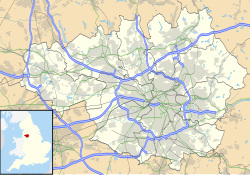History
The house incorporates elements from different periods. Inscribed stones bear the initials "RL 1611" (Robert Lightowlers) and "IBI 1635" (John Butterworth), indicating phases of construction in the early 17th century. The rear wing, dated 1611, predates the main range and was originally a free-standing single-cell house before being linked to the main structure in the mid-17th century. The main range dates from 1635. [1]
On 2 January 1967, it was designated a Grade II* listed building. [2]
Architecture
Windy Bank is constructed in hammer-dressed stone with a graduated stone-slate roof and retains elements of vernacular architecture. The building originally incorporated a timber-framed structure, possibly dating from the early 16th century, although this was later removed. It follows a three-unit hearth-passage plan with a rear wing. [2]
The house stands on a projecting plinth and features quoins, gargoyles, and a roof with coped gables and finials. Its plan is L-shaped, comprising a main range and a rear wing, the latter being the earliest section. The property is of two storeys; the main range consists of four bays and is surmounted by three gables. The windows are mullioned, some with hood moulds. [2]
Internally, the house retains significant historic features. The hall contains arched and moulded fire surrounds, chamfered beams with stepped stops, and remnants of timber-framed roof trusses, including a king-post truss over the hall. The rear wing preserves an original boarded door, a bread oven within the gable stack, and roof trusses with diagonal struts. Later alterations include a 19th-century extension and 20th-century additions, such as a porch and garage. [1]
This page is based on this
Wikipedia article Text is available under the
CC BY-SA 4.0 license; additional terms may apply.
Images, videos and audio are available under their respective licenses.




